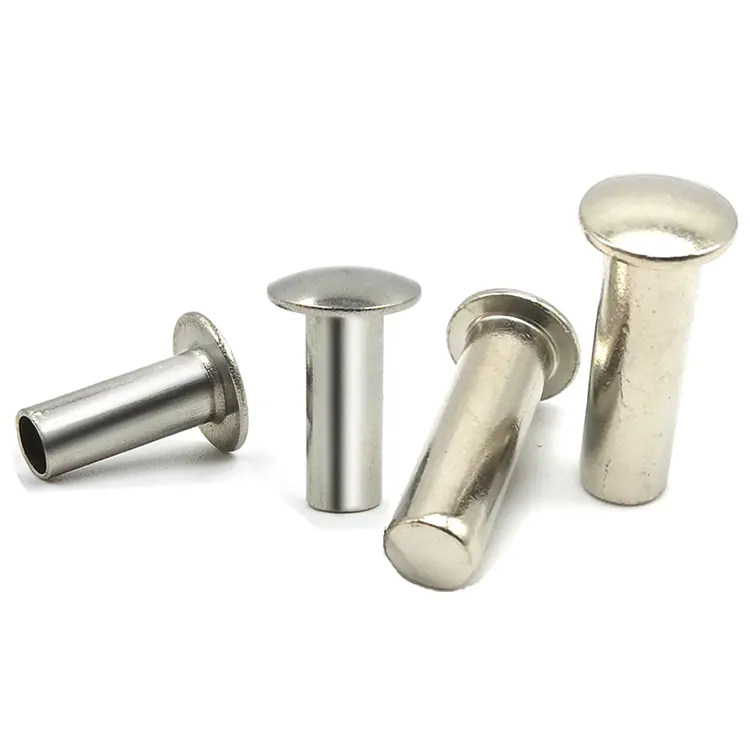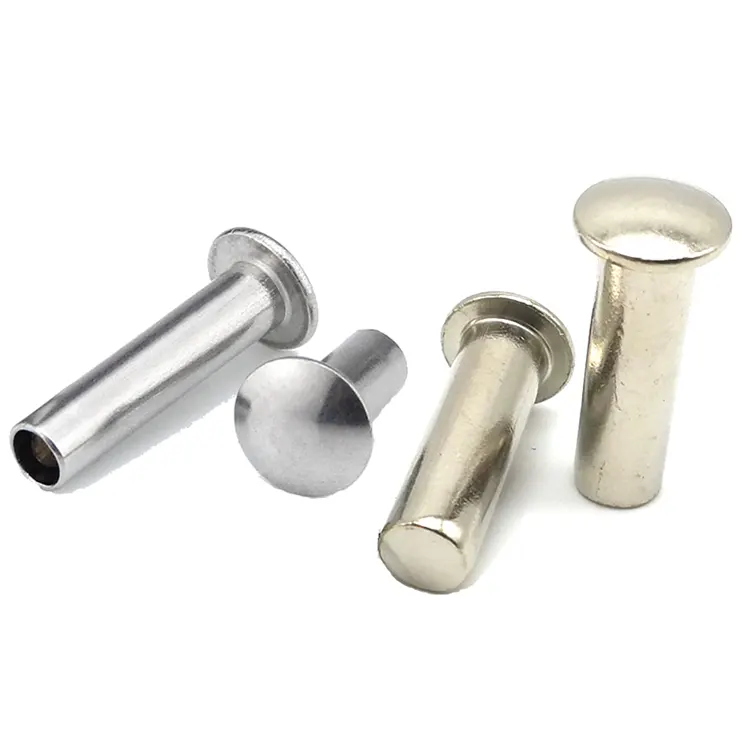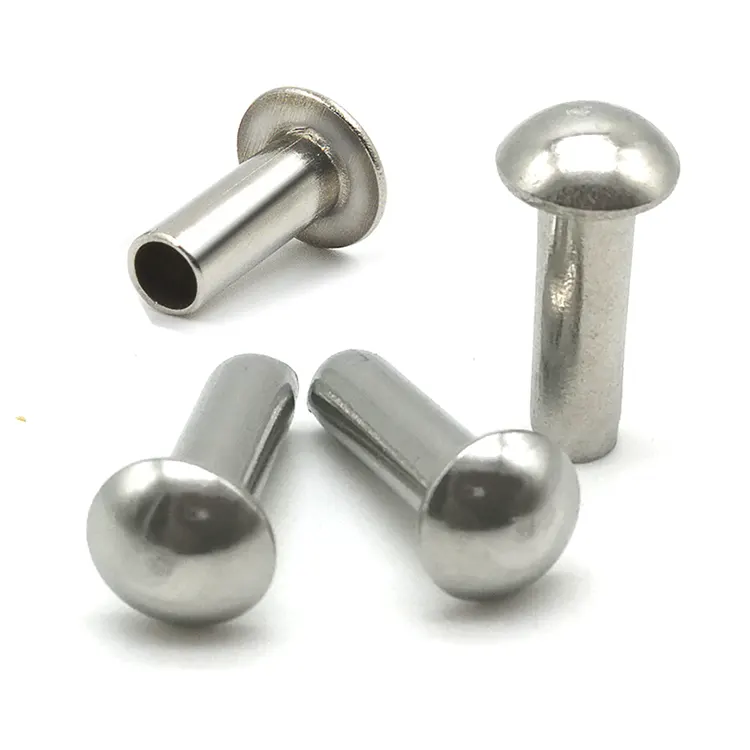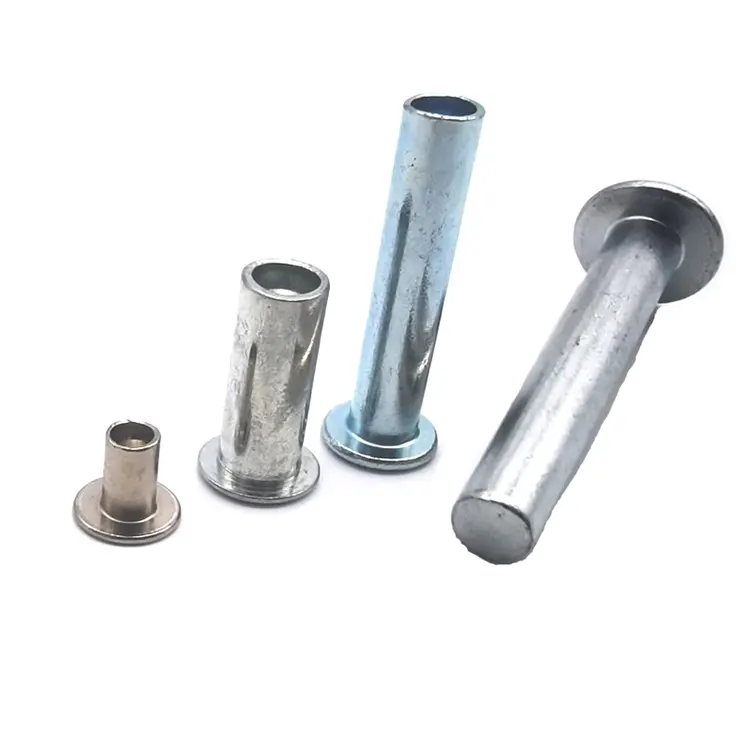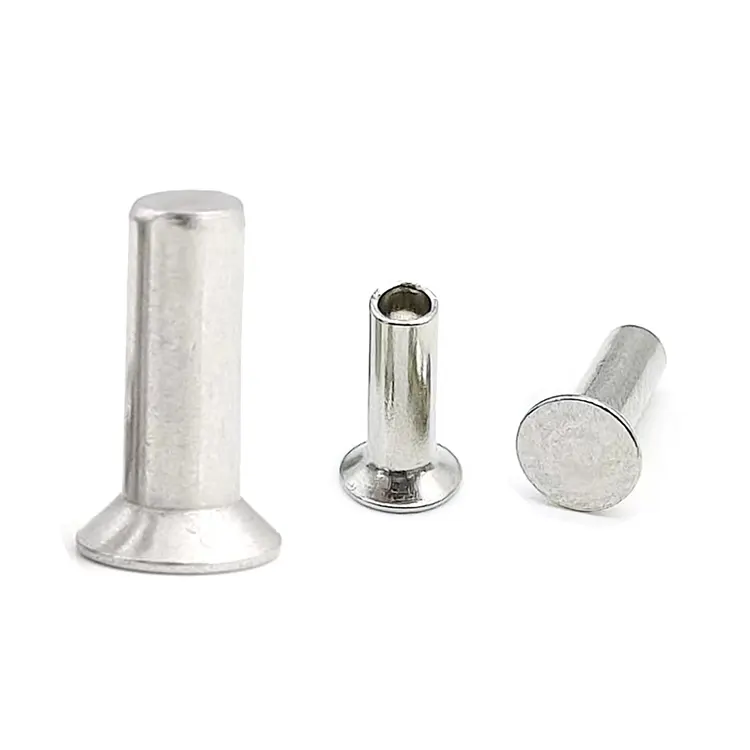Nitar
As one of professional manufacturer in China, Notin would like to provide you Rivets. And we will offer you the best after-sale service and timely delivery.
What is a rivet?
A rivet is a permanent mechanical fastener used to join two or more materials. Rivets work by inserting a metal pin into an aligned hole and deforming the end, creating a strong, secure, and durable connection. Unlike temporary fasteners like screws, rivets do not rely on threads, but instead form a permanent connection, making them ideal for applications requiring high strength, durability, and vibration resistance.
Classification of Rivets
Rivets are typically categorized by head shape, degree of hollowness, or material.
Based on head shape, rivets can be classified as flat head rivets, round head rivets, countersunk head rivets, mushroom head rivets, universal head rivets, truss head rivets, etc.

Based on degree of hollowness, rivets can be classified as solid rivets, semi-tubular rivets, or full tubular rivets.
Based on material, rivets can be classified as brass rivets, stainless steel rivets, steel rivets, aluminum rivets, copper rivets, etc.

What surface finishes are available for rivets?
Rivet surfaces are typically treated with rust-proofing treatments, primarily electroplating, including zinc plating, nickel plating, chrome plating, tin plating, gold plating, and silver plating. Electroplating is a common rust-proofing method for rivets. It applies a layer of plating to the rivet surface through physical or chemical methods. The plating effectively prevents corrosion and rust, while also providing a certain aesthetic effect.
Another special surface treatment method is head coating. Head coating is performed after the rivet is electroplated. This allows for a variety of colors on the rivet head, achieving an aesthetically pleasing finish.
Aluminum rivets cannot be electroplated, but they can be anodized. Anodizing also allows for a variety of color options, but the unit price is higher than electroplating.
Rust-proofing the rivet surface is crucial, effectively extending the rivet's service life and ensuring a secure connection. Different rust-proofing methods are suitable for different environments and applications, so the choice should be tailored to the specific situation.
- View as
Stålnitar
Kolstålnitar är ett vanligt mekaniskt fästelement som används i en mängd olika industriella och vardagliga produkter. Deras primära funktion är att säkert koppla ihop två eller flera komponenter, vilket skapar en stabil struktur. Kolstålnitar är populära på grund av sin styrka, hållbarhet och kostnadseffektivitet. Nuote Metals har tillverkat kolstålnitar i över ett decennium. Beläget i Dongguan, Kina, känd som "World's Factory", välkomnar vi besökare från hela världen att besöka oss.
Läs merSkicka förfråganNitar med pannhuvud i stål
Nitar med stålpannor är ett vanligt industriellt fästelement som används i ett brett spektrum av applikationer, inklusive fordon, flyg och konstruktion. Nuote Metals specialiserar sig på tillverkning av stålnitar med pannhuvud, som säljs över hela världen. Vi erbjuder ett brett utbud av nitar gjorda av olika material, inklusive mässing, rostfritt stål, aluminium och koppar. Vi kan också skräddarsy våra produkter med olika ytbehandlingar, såsom galvanisering, betning och anodisering, för att möta kundernas krav.
Läs merSkicka förfråganNitar för svamphuvud i stål
Nitar för svamphuvud av stål, även kända som kupolförsedda huvudnitar, används ofta i industriella tillämpningar. Deras unika form av svamphuvud och stålkonstruktion ger en säker och pålitlig anslutning för en mängd olika strukturer. Nuote Metals är specialist på nitar för svamphuvuden i stål. Våra nitar säljs över hela världen och har fått erkännande från både inhemska och internationella kunder. Vi välkomnar dina förfrågningar och möjligheten att betjäna dig.
Läs merSkicka förfråganPlatta nitar av stål
Plannitar av stål förbinder komponenter säkert genom deformation eller interferenspassning, vilket säkerställer att de förblir oskiljaktiga och lämpliga för tillämpningar som utsätts för allmänna belastningar. De kan också ytbehandlas med nickel, vit zink, blå zink, svart zink, färgad zink, koppar eller krom för att passa olika miljöer och estetiska krav. Nuote Metals är specialiserat på tillverkning av plattnitar av stål, frakt över hela världen. Anpassade beställningar är också välkomna.
Läs merSkicka förfråganFörsänkta huvudnitar i stål
Nitar med försänkt huvud av stål är ett vanligt använt fästelement som används för att ansluta två eller flera arbetsstycken. De fästs vid arbetsstyckena med slag eller mekanisk kraft, vilket skapar en säker anslutning. Nuote Metals är specialist på tillverkning av stålnitar med försänkta huvuden, beläget i Dongguan, Kina, en stad med en blomstrande industri. Våra nitar har en slät, gradfri yta, felfri plätering och sprickfria fogar. Vi välkomnar förfrågningar och beställningar.
Läs merSkicka förfråganNitar med rund huvud i rostfritt stål
Nitar med runda huvud ger utmärkt korrosionsbeständighet. Detta gäller särskilt för 304 rostfria nitar med rund huvud, som är gjorda av 304 rostfritt stål, ett material känt för sin utmärkta korrosionsbeständighet, goda bearbetbarhet och estetiskt tilltalande finish. 304 rostfritt stål motstår angrepp från ett brett spektrum av kemikalier, vilket gör den idealisk för användning i våta och korrosiva miljöer. Som ett resultat ger 304 rostfria nitar med rund huvud en längre livslängd i utomhus eller fuktiga miljöer, är mindre benägna att rosta och erbjuder låga underhållskostnader.
Läs merSkicka förfråganWhat are the advantages of rivets over other fasteners?
1. Ease of Installation
Rivets are fast to install, and even fully automated for high-volume applications, resulting in a simple and efficient operation process.
2. Connection Reliability
The riveting process is standardized, with strict quality control, resulting in highly stable connections. Visual inspection allows for quick verification of connection quality.
3. Vibration and Impact Resistance
Rivets connect through deformation or interference fit, providing strong clamping force and excellent vibration resistance, capable of withstanding vibration and shock.
4. Low Cost
Rivets are easy to install and can be fully automated, saving significant labor costs.
What are the advantages and disadvantages of rivets made of different materials?
Aluminum Rivets
Advantages: Lightweight, reduces overall product weight, low cost, suitable for general civilian applications.
Disadvantages: Low tensile and shear strength, unsuitable for high-strength workpieces, prone to electrochemical corrosion when in contact with metals such as stainless steel.
Stainless Steel Rivets
Advantages: Strong corrosion resistance, high hardness, suitable for high-strength workpieces (such as marine equipment)
Disadvantages: Higher cost, typically more expensive than aluminum rivets of the same specification.
Brass and Copper Rivets
Advantages: Excellent conductivity (such as connecting electronic components), good corrosion resistance.
Disadvantages: Higher cost, more difficult to process.
Steel Rivets
Advantages: High hardness, high connection reliability, and wide applicability.
Disadvantages: Compared to other materials, iron rivets are more prone to rusting.
What are the main applications of rivets?
Rivets have a wide range of uses, from small items like a pair of scissors to large items like airplanes and ships, as well as in high-precision medical applications.
Industrial Manufacturing
Rivets are used in a wide variety of industrial fields, wherever there is a need to connect two or more materials.
Electronics
Rivets secure heat sinks and chips, providing both vibration damping and noise reduction, and are widely used in the cooling systems of electronic products such as computers and mobile phones.
Automotive
Rivets are widely used to connect components of automobile bodies and chassis, such as doors and hoods. Their lightweight and corrosion-resistant properties make them an indispensable joining method in automotive manufacturing.
Aerospace
In aircraft manufacturing, rivets are used to connect different fuselage components, such as wings and tailplanes. Millions of rivets create high-strength, corrosion-resistant joints. Aluminum and titanium alloy rivets are often used to connect components of corresponding materials, ensuring stability in extreme environments.
Rivets are used everywhere. The above examples only represent a small number of their applications. We see rivets everywhere in our daily lives, such as on scissors, folding beds, and strollers etc. Rivets can be customized to different sizes and materials depending on the application.
Nuote Metals has specialized in the rivet industry for over a decade. Our factory is located in Dongguan, a city known as the "World Factory," a city with a developed industry and convenient transportation. This allows us to respond quickly when acquiring raw materials and supporting surface treatments, meeting our customers' needs for quick access to samples and bulk orders. We produce 10 million rivets daily and have molds of various specifications, allowing us to produce rivets as small as 0.8mm and as large as 10mm. We welcome your inquiries and visits.







